If you were expecting some kind of sun sign nonsense, forget about it. This is real astrology for the real world, not some mystical mumbo-jumbo word salad. If it's real astrology for yourself that you want, you can get it by phone or in print. And if you need help deciphering the astrological glyphs in the graphics accompanying this article, see Astroglyphs: Astrological Symbols Guide. Please note: this forecast is expressed in terms of Universal Time (UT). Also please be aware that, while I never change a forecast once it's published, I do post errata to acknowledge typographical errors and the like.
Le futur n'est pas ce qui vient vers nous, mais ce vers quoi nous allons.
(The future is not what is coming at us, but what we are headed for.)
-- Jean-Marie Guyau
 Mars Max, Mercury Max, another SuperMoon (the last one this year, and a partial solar eclipse to boot), and a long and lingering Mercury-Venus alignment Ė it all adds up to an energetic November. The Mars Max started last month (on the 28th, actually), the Mercury Max begins on the 14th, the SuperMoon solar eclipse falls on the 25th, and Mercury stays within just a few degrees of Venus all the way through the 19th.
Mars Max, Mercury Max, another SuperMoon (the last one this year, and a partial solar eclipse to boot), and a long and lingering Mercury-Venus alignment Ė it all adds up to an energetic November. The Mars Max started last month (on the 28th, actually), the Mercury Max begins on the 14th, the SuperMoon solar eclipse falls on the 25th, and Mercury stays within just a few degrees of Venus all the way through the 19th.
With all this cosmic confluence going on, itís hard to know where to start. Mars Max arguably deserves pride of place, if only because itís the longest lasting of Novemberís celestial cycles. Considering that itís a cycle that comes only once every couple of years and lasts from its beginning on October 28, 2011 to its end on July 12, 2012, this one deserves a closer look. (Iíve already described the celestial dynamics of this cycle in last monthís forecast.)
Mars phases of this sort happen once every couple years or so; the last one ran from fall 2009 to spring 2010, and the current one that started in October 2011 lasts into early summer 2012. Obviously, we've survived plenty of them to date. This isn't Armageddon, in other words. It's just a predictable upsurge in the already considerable nominal human penchant for mayhem: plenty sufficient to make for a surfeit of those "if it bleeds, it leads" headlines, but not likely the harbinger of the next world war - let alone some kind of mass extinction event. Such Red Planet close approaches are not unlike the Max cycles of Mercury and Venus, in that they emphasize the nature of the planet in question during that portion of its orbit where it passes closest to Earth. So the high Mars cycle that begins in October 2011 and concludes in July 2012 indicates a period of elevated tension and conflict, the kind of atmosphere that cultivates inflamed passions, hot tempers and rash, reckless, even violent action - of the criminal and military type, from terrorist atrocities to large scale military conflict. (Not to mention the smaller scale stuff like domestic violence, school and workplace shootings, mass murders and spree killings, etc.) A notable increase in dangerous fires, crashes and explosions is also typical of the Mars Max cycle, which is accompanied by rash, hasty and impulsive action generally.
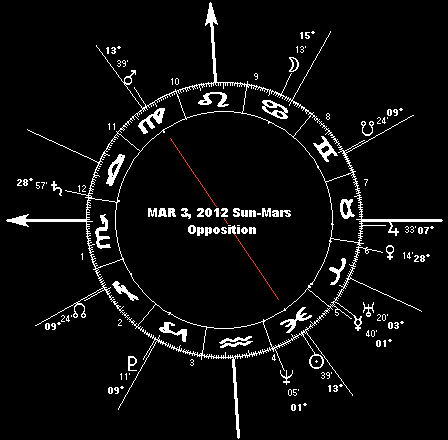 Apart from the direct impact of the fires, clashes, crashes and explosions that are par for the course under this sort of Mars close pass, some such incidents can raise the possibility of a disruption in the oil and natural gas supply chain - which in turn can shock the financial markets and set investors and institutions in a mad dash for the exits. Military conflicts can have the same effect - and not only on energy supplies specifically, but on the whole spectrum of commerce. The centerpiece of this particular Mars Max, the March 2012 Sun-Mars opposition, also features a Venus-Saturn alignment; which suggests a strong potential for greater or lesser financial panics stemming from mishaps and misadventures associated with this Mars cycle - and certainly not only around the time of the Sun-Mars and Venus-Saturn alignments themselves, but throughout the Mars Max phase.
Apart from the direct impact of the fires, clashes, crashes and explosions that are par for the course under this sort of Mars close pass, some such incidents can raise the possibility of a disruption in the oil and natural gas supply chain - which in turn can shock the financial markets and set investors and institutions in a mad dash for the exits. Military conflicts can have the same effect - and not only on energy supplies specifically, but on the whole spectrum of commerce. The centerpiece of this particular Mars Max, the March 2012 Sun-Mars opposition, also features a Venus-Saturn alignment; which suggests a strong potential for greater or lesser financial panics stemming from mishaps and misadventures associated with this Mars cycle - and certainly not only around the time of the Sun-Mars and Venus-Saturn alignments themselves, but throughout the Mars Max phase.
Being months in duration and planetary in scale, you can pretty well figure that Mars Max effects will be seen worldwide. But there may be one very broad hint as to areas of particular vulnerability during this cycle. Astro-locality mapping the March 3, 2012 Sun-Mars opposition that anchors the 2011-2012 Mars Max cycle reveals several longitudinal special risk zones, including one in the western US from southern California in the vicinity of Los Angeles due north through western Canada, passing over the pole to come down through Russia and the Middle East in the area of the border Iran shares with Afghanistan and Pakistan. Except for skimming the far north of Canada and the southern tip of Greenland, the Sun-Mars horizon arc mostly spans open ocean - except where it touches eastern Australia (around Melbourne), Papua New Guinea and New Britain on its way across the Pacific to the Kamchatka Peninsula and the coast of Siberia.
Once the history of the 2011-2012 Mars Max cycle is written, the above-mentioned danger zones will figure prominently - though certainly not exclusively - when it comes to the "if it bleeds, it leads" headlines of the times: the fires, crashes, explosions, military/paramilitary attacks (including terrorism) and criminal violence, etc. Astro-locality mapping the Sun-Mars opposition anchor of the 2009-2010 Mars Max showed Afghanistan right under the Mars meridian line for this alignment, for example. That was indeed the locus for the biggest military conflict of the year, but there was a whole lot more to the Red Planet story during that period. As I wrote in my 2010 forecast, "these are some but not all of the focal zones for the alignment." And so it will be for the Mars Max that just got underway last month.
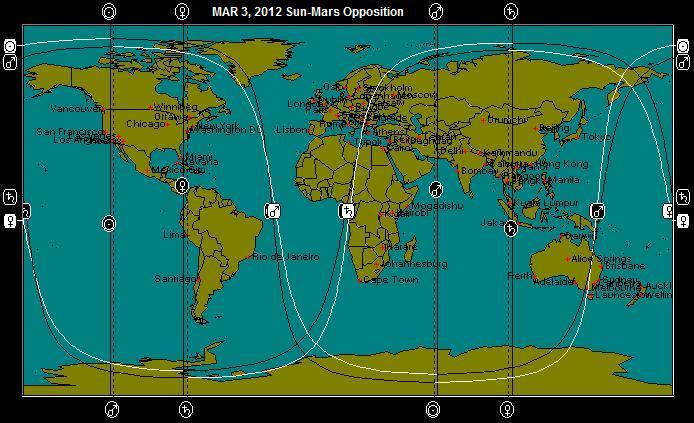 We'll have plenty of time to watch the headlines and observe the Mars Maximum correlates as they develop. Just remember that they don't develop only `out there' in the world at large. They're also alive in us, in the people around us. This is a time to be safety conscious, to get a grip on the animal spirits within and channel them productively rather than letting them loose on anyone who gets your goat. If people are cranky, if you're short tempered too, realize that this is just the nature of the space-time field for now, and do your best to ride it out with as little drama and damage as possible.
We'll have plenty of time to watch the headlines and observe the Mars Maximum correlates as they develop. Just remember that they don't develop only `out there' in the world at large. They're also alive in us, in the people around us. This is a time to be safety conscious, to get a grip on the animal spirits within and channel them productively rather than letting them loose on anyone who gets your goat. If people are cranky, if you're short tempered too, realize that this is just the nature of the space-time field for now, and do your best to ride it out with as little drama and damage as possible.
This is a long term, background kind of cycle, so itís more or less omnipresent throughout the whole period Ė including all of November, of course. But in particular this month, the Mars-Neptune opposition on the 7th (within a few degrees of exact from the 1st through the 15th) looks especially notable; and figures into elevated significance patterns on the 3rd and 4th as well. Thereís also the Moon-Mars alignment on the 19th. These are times to stay focused, calm and collected as best you can, steering clear of conflict and danger as much as possible.
Itís well worth remembering that nothing exists in isolation: everything is connected to everything else, and the Mars Max is one among many ongoing and simultaneous cycles. For example, thereís the Uranus-Pluto square that grew out of the Saturn-Uranus opposition that grew out of the Jupiter-Saturn-Neptune T-Square, which in turn fell smack in the middle of the Trigonalis Dawn Ė the period between 1980 and 2020, which Iíve been writing about for years now. Iíll put all this into perspective in my 2012 World Forecast Highlights.
For now, letís just say that the "panic in the markets, panic in the streets, people in need of rescue, just a whiff of revolution in the air" Iíve been describing as a backdrop to world events these past few years has been exacerbated by strong Mars factors in the sky. These will continue to be heightened in the current Mars Max cycle, so donít expect the Arab Spring, Occupy Wall Street and similar revolutionary movements to go quietly away. Yes, this one and that one will peter out, but the underlying movement will live to fight another day. Anyone who thinks that the crises of the day will go quietly away is like King Louis XVI asking if the storming of the Bastille was a revolt, only to be told "No, Sire, itís a Revolution." (Which revolution, incidentally, followed in the wake the 1782-83 Saturn-Uranus oppositions and attendant volcanic eruptions and climate change.) Sound familiar? Look at the headlines and the news, read my world forecasts for the last several years.)
The other Max cycle getting underway this month belongs to Mercury. Being closest to the Sun, Mercury goes between Earth and Sun more than any other planet; several times a year in fact, including the infamous Mercury retrogrades of astrological legend. While most astrologers pay a fair amount of attention to Mercury's retrograde, few realize that it's only a part of the more fundamental intersolar phase in the orbital interaction between Mercury and Earth, as they both orbit around the Sun.
 The Mercury Max phase begins when the little Sun-grazer reaches its maximum elongation east of the Sun - its evening star phase. This happens when Mercury has come 'round to the same side of the Sun as Planet Earth, and is relatively near us. The little planet is then pulling up to pass Earth on the inside track, as it were; catching up to us from behind and then passing between us and the Sun. (This catching up is in fact the cause of the so-called Mercury retrograde.) Just as it catches up with us, Mercury passes directly between Earth and the Sun. This is Mercury's inferior conjunction with the Sun. (If the alignment is exact in right ascension and declination, the little dot that is Mercury is actually seen to transit across the face of the Sun.) After the inferior conjunction, Mercury continues pulling ahead of us until it reaches its greatest elongation west of the Sun (its morning star phase), at which point the little planet is headed toward the far side of our parent star. Between these two extremes, the greatest east and west elongations, comes the fabled Mercury retrograde period of astrological lore.
The Mercury Max phase begins when the little Sun-grazer reaches its maximum elongation east of the Sun - its evening star phase. This happens when Mercury has come 'round to the same side of the Sun as Planet Earth, and is relatively near us. The little planet is then pulling up to pass Earth on the inside track, as it were; catching up to us from behind and then passing between us and the Sun. (This catching up is in fact the cause of the so-called Mercury retrograde.) Just as it catches up with us, Mercury passes directly between Earth and the Sun. This is Mercury's inferior conjunction with the Sun. (If the alignment is exact in right ascension and declination, the little dot that is Mercury is actually seen to transit across the face of the Sun.) After the inferior conjunction, Mercury continues pulling ahead of us until it reaches its greatest elongation west of the Sun (its morning star phase), at which point the little planet is headed toward the far side of our parent star. Between these two extremes, the greatest east and west elongations, comes the fabled Mercury retrograde period of astrological lore.
Itís worth noting that with the inferior planets (those inside Earthís orbit; namely Mercury and Venus), the closest approach to Earth coincides with the inferior (retrograde) conjunction with the Sun. With the superior planets (those outside Earthís orbit), the closest approach to Earth coincides with the planetís (retrograde) solar opposition. Clearly astrological tradition regarding planetary retrogrades is completely unthinking. Rather than being weakened or debilitated in some way, a retrograde planet is in fact bigger and brighter in our sky, and closer to our home planet. Not unlike a SuperMoon, in that respect . . . Accordingly, Mercury Max is a peak Mercury experience, with the little planet shining brighter than usual as the evening star at the beginning of the intersolar phase.
What I have termed the Mercury Max cycle is a way of putting the Earth-Sun-Mercury relationship into a perspective that reflects real-sky, observational astronomy; the dynamics of our solar system as seen from our home planet perch Ė which is what astrology was, back in the time when it was astronomy. Look up in the sky over the indicated period, and you will see the phenomena described above. This perspective replaces the stilted, removed-from-reality practice of looking not at the sky, but at an ephemeris: first to see when Mercury comes to the degree at which it will later makes its direct station, and second when it reaches the degree at which it will later make its retrograde station; and then referring to the overlap between these two dates and the lesser included Mercury retrograde dates as the "shadow" and "storm" phases of the retrograde. (Some astrologers donít use the "storm" nomenclature, referring to the overlap at both ends of the retrograde as the "shadow" period. It makes no difference: either way, it's just plain nonsense.)
For example, the current Mercury Max cycle begins with the little planetís maximum eastern elongation from the Sun on November 14, includes the November 24-December 14 retrograde and the December 4 inferior conjunction, and wraps up with the western elongation extreme on December 23, 2011. The corresponding shadow period would begin on November 5
(the day Mercury reaches the degree at which it goes direct on December 14) and ends (or the storm period ends, depending on nomenclature) on January 1, 2012 (the day Mercury returns to the degree at which it went retrograde on November 24). But in terms of any organic, visible manifestation in the skies of our home planet, these ephemeris-derived dates have no relevance to the Earth-Sun-Mercury dynamic. Itís like left-brain versus right-brain thinking, linear versus holistic; nose in the book versus eyes on the skies. One is a made-up abstraction looked up in an ephemeris, the other a reality that can be seen in the sky. The corresponding organically derived dates in this case are November 14 (greatest eastern elongation) and December 23 (western elongation maximum). Occasionally the real Mercury Max begin and end dates will coincide with the artificial so-called shadow period start and stop dates. Even a broken clock is right twice a day. But the reality is there to see in the sky.
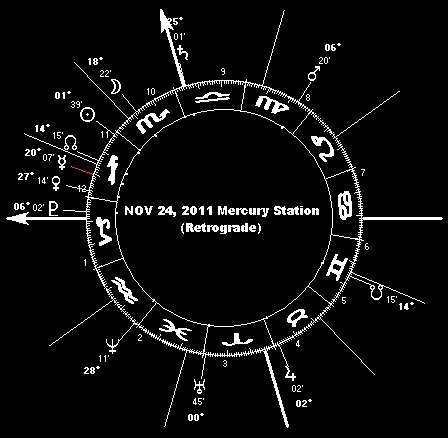 Retrograde means moving backwards. This is what Mercury appears to do in our skies when the little inner planet catches up on us and passes us on the inside, between Earth and the Sun. The reality of course is that Mercury never stops in its orbit, and never moves backward: this is only how the relative motions of Earth and Mercury around the Sun cause Mercury to move through our night sky.
Retrograde means moving backwards. This is what Mercury appears to do in our skies when the little inner planet catches up on us and passes us on the inside, between Earth and the Sun. The reality of course is that Mercury never stops in its orbit, and never moves backward: this is only how the relative motions of Earth and Mercury around the Sun cause Mercury to move through our night sky.
Mercury retrograde is the cycle when everything goes wrong, to hear some astrologers tell it. The truth is not so simple-minded. All things Mercurial are crucial during the intersolar Mercury phase; infrastructure, commerce, information, communication and transport being prime examples. Absent careful investigation and planning, and conscientious follow-through, all such things are apt to go off track during these cycles. Mercury's intersolar (Max) phase is a time for focus, concentration, planning, follow-through and communication - all the qualities of the active and involved mind, in short. In case you haven't noticed, most people are not especially alert and focused most of the time. When this kind of sleepwalking runs into Mercury's intersolar cycle, with its focus on mental acuity, it doesn't take long for things to go awry.
Iím confident that fear of the different (Mercury apparently moving backwards in the sky) gave rise to the paranoia about Mercury retrograde. This paranoia was fed down through the generations by the fact that most people are more or less, to use Gurdjieffís term, sleepwalking most of the time. Comes a time when real awareness and focus is called for, those sleepwalkers run into a virtual (sometimes literal) buzz saw. If you're sharp and focused and alert, you can avoid a certain amount of this mess. In fact, you can even prosper by concentrating on tasks that center on thought, planning and communication. But you'll still have to dodge all the chaos created by the people who are sleepwalking. Itís like driving in city traffic full of bozos who are texting behind the wheel . . .
Among the sort of things to be ready for during this and Mercury Max: strikes and other disruptions affecting transportation and communication (e.g. postal, phone, mass transit, trucking, airline, shipping, dock and warehouse workers, teachers and all manner of media). Weather both terrestrial and solar (including geomagnetic storms, particularly during other planetary Max phases, most especially Venus, Mars and Jupiter) can play a part in the kind of breakdowns described here, but human effort (and sometimes malicious action) is a part of the mix as well. Power failures due to infrastructure breakdown and computer network disruptions caused by hacker attacks, software vulnerabilities and the like are also just a crossed wire or a keystroke away from a major mess at these times.
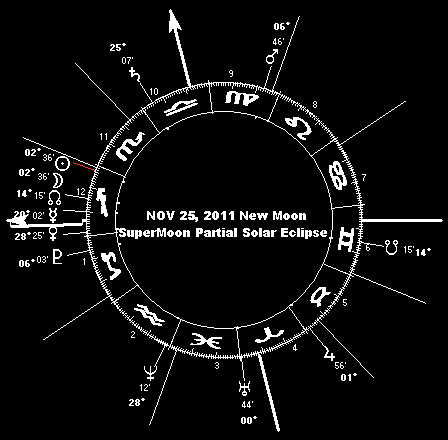 If I had to pick a day to have a backup generator all fueled up and ready to go, a contingency plan in place in case the scheduled or expected didn't come to pass, a day to be especially sharp and steady and focused - it would be during one of these Mercury cycles. Note these dates; be ready with a fallback plan just in case. It's not so much that disaster is destined to strike when Mercury is in its intersolar phase. Rather, it's that everything pertaining to Mercury becomes crucial; and unless it's treated as such, then it goes awry. More and more, we live in a "just in time" world - and if the slightest delay holds up just one single thing, then a whole process screeches to a halt. Unfortunately, few people keep their eye on the ball with any consistency and diligence. And that's the reason these Mercury cycles tend to turn into Murphy's Law festivals. Practically speaking, this means that having a "just in time" inventory of essentials is risky business at times like this. Don't say I didn't warn you!
If I had to pick a day to have a backup generator all fueled up and ready to go, a contingency plan in place in case the scheduled or expected didn't come to pass, a day to be especially sharp and steady and focused - it would be during one of these Mercury cycles. Note these dates; be ready with a fallback plan just in case. It's not so much that disaster is destined to strike when Mercury is in its intersolar phase. Rather, it's that everything pertaining to Mercury becomes crucial; and unless it's treated as such, then it goes awry. More and more, we live in a "just in time" world - and if the slightest delay holds up just one single thing, then a whole process screeches to a halt. Unfortunately, few people keep their eye on the ball with any consistency and diligence. And that's the reason these Mercury cycles tend to turn into Murphy's Law festivals. Practically speaking, this means that having a "just in time" inventory of essentials is risky business at times like this. Don't say I didn't warn you!
While the above descriptions apply to the Mercury Max period as a whole, we can expect that extremes will be associated with particular milestones the little planet makes along the way, give or take a few days. Middle November is a good example, what with Mercury reaching greatest elongation east of the Sun in the midst of the long-lasting Mercury-Venus conjunction. And then thereís the November 24 retrograde station; and in December, the 4th, 14th and 23rd Ė again, all give or take a few days.
The current Mercury Max cycle is the last one of 2011, by the way. Next up is the March 5-April 18 cycle Ė about which Iíll have more to say in my 2012 World Forecast Highlights.
Among the major celestial signposts this month is the only eclipse SuperMoon of the year, the partial solar eclipse at 2° 36í Sagittarius on November 25. (There wonít be another SuperMoon until the April 6, 2012 full moon.) This is the final solar eclipse of 2011, and will be visible from the tip of South Africa, Antarctica, Tasmania and most of New Zealand. This eclipse belongs to Saros Series 123, which began in 1074 Ė the year that Roman Catholic priests were forbidden to marry. Might one expect that such an inhumane policy would come up for review under this latest apparition in the Saros 123 series? Possibly Ė but no change in policy. Being both an eclipse and a SuperMoon, itís reasonable to expect that this is very likely the riskiest storm and seismic shock window of the fourth quarter. Add in the Mercury Max cycle, which is already underway as this geocosmic shock window opens, and this shapes up to be one of the more disruptive storm and seismic events of the year.
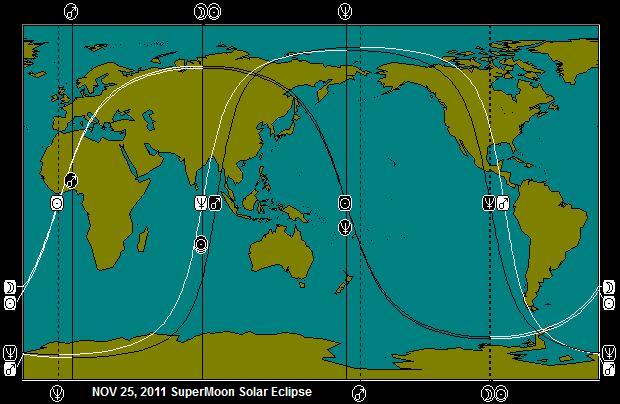 In effect from November 18 into December 4, this SuperMoon eclipse looks to be most potent around November 20, 23, 25 and 26, plus December 3. As for its storm and seismic implications, expect the usual: severe storms, moderate-to-severe earthquakes and volcanic eruptions, extreme tides, etc. Of course these can happen just about anywhere on Earth, but the places where the eclipse is visible rank high on the suspect list. In addition, astro-locality points to central Asia as one danger zone (along a meridian from Russia down through Kazakhstan, western China, Nepal and eastern India). Another longitudinal danger zone lies halfway Ďround the world, through the center of North America (roughly along a line from Winnipeg south to Mexico City). Thereís also a horizon arc running northeasterly across west Africa into Italy and across eastern Europe, crossing northern Russia before dipping down over Japan and out into the South Pacific (running right through Fiji). Wherever youíll be during the November 25 SuperMoon eclipse shock window, be prepared for infrastructure damage due to Mother Nature: power outages, travel delays, communication and network disruption, etc. But if you happen to be in one of the above indicated zones Ė well then, you might want to double up on your preparations.
In effect from November 18 into December 4, this SuperMoon eclipse looks to be most potent around November 20, 23, 25 and 26, plus December 3. As for its storm and seismic implications, expect the usual: severe storms, moderate-to-severe earthquakes and volcanic eruptions, extreme tides, etc. Of course these can happen just about anywhere on Earth, but the places where the eclipse is visible rank high on the suspect list. In addition, astro-locality points to central Asia as one danger zone (along a meridian from Russia down through Kazakhstan, western China, Nepal and eastern India). Another longitudinal danger zone lies halfway Ďround the world, through the center of North America (roughly along a line from Winnipeg south to Mexico City). Thereís also a horizon arc running northeasterly across west Africa into Italy and across eastern Europe, crossing northern Russia before dipping down over Japan and out into the South Pacific (running right through Fiji). Wherever youíll be during the November 25 SuperMoon eclipse shock window, be prepared for infrastructure damage due to Mother Nature: power outages, travel delays, communication and network disruption, etc. But if you happen to be in one of the above indicated zones Ė well then, you might want to double up on your preparations.
We have only to look back on the October 26 SuperMoon to get some idea of what these alignments tend to usher in: from Turkeyís worst earthquake in a decade to the eruptions of the Etna and Hudson volcanoes in Italy and Chile to the unseasonably heavy late October snowstorms in the US . . .
Iíd be remiss if I didnít mention other (although much lesser) geocosmic shock windows this month, surrounding the Moonís northward crossing of the celestial equator on the 5th, and the full moon on the 10th (and effective from about the 7th through the 13th). Here again, thereís an elevated risk of notable storm and seismic activity, the kind of thing that makes the Boy Scout motto look pretty savvy. Candles and batteries and canned goods and bottled water arenít sexy, but theyíre mighty handy when you really need them.
Last but not least, remember that the October rally in world equity markets wasnít the start of a one-way rocket ride to the top. Sharp downtrends are likely in the period marked by the Moon alignments with Mars and Saturn (on the 19th and 22nd respectively), the month-long Mercury-Venus alignment breaking up on the 19th, and Mercuryís retrograde station on the 24th. Given that Venus Max Ė the cycle that timed the March 2009 and August 2010 market rallies Ė wonít return until March 2012, Iím looking for a trading range to be the big story until then. The Uranus-Pluto square, after all, starts forming again when Uranus goes direct in December . . . and moves to within a few degrees of exact once more in April 2012, heading for the first of seven 2012-2015 square alignments on June 24. And in any event, as Iíve been writing for years now, it looks as though what passes for a full recovery wonít be here until the 2020 Jupiter-Saturn Trigonalis Ė which signals the arrival of what amounts to a new civilization, much as the Industrial Revolution supplanted the agricultural civilization in the wake of the last Trigonalis. (For more on this, review my previous annual World Forecast Highlights, and watch for the 2012 edition.)
 SPECIAL FEATURE: This month's birthdays of the famous and infamous (with astrological birth charts)
SPECIAL FEATURE: This month's birthdays of the famous and infamous (with astrological birth charts)